Cartoon Caricatures of Cab Calloway
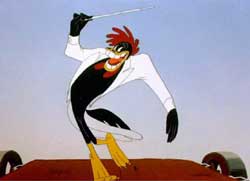 Cab was regularly caricatured in animated cartoons, beginning with the Fleisher brothers' Betty Boop classics Minnie the Moocher (1932) The Old Man of the Mountain (1933), & Snow White (1933) in which Cab is caricatured respectively as a ghost-walrus, a cave hermit, & a transmogrified Koko the Clown. As Koko, Cab even participated in the caricature providing the voice & being filmed beforehand, his dance moves rotoscoped.
Cab was regularly caricatured in animated cartoons, beginning with the Fleisher brothers' Betty Boop classics Minnie the Moocher (1932) The Old Man of the Mountain (1933), & Snow White (1933) in which Cab is caricatured respectively as a ghost-walrus, a cave hermit, & a transmogrified Koko the Clown. As Koko, Cab even participated in the caricature providing the voice & being filmed beforehand, his dance moves rotoscoped.
In Swooner Crooner (1944) we're taken down to Porky Pig's chicken farm, where egg production is down because the hens are too busy adoring a crooner rooster who is a caricature of Frank Sinatra.
To perk up the hens, Porky arranges auditions for an Al Jolson rooster, Cab Calloway rooster, Rudy Vallee rooster, Nelson Eddy rooster, Jimmy Durante rooster, & Bing Crosby rooster. Cab's flopping hair becoming the rooster's comb.
Rooster Cab sings "Blues in the Night" & is underutilized compared to Rooster Frank & Rooster Bing.
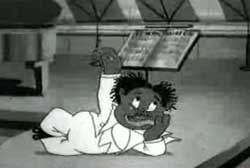 Porky at the Crocadero (1938) regards a jazz club called the Crocadero. Porky Pig has just graduated from Sucker Correspondence School of Music & believes he'll soon be leading a band. He turns up at the Crocodero to meet who he believes are his soon-to-be-peers, including he hopes Cab Calloway.
Porky at the Crocadero (1938) regards a jazz club called the Crocadero. Porky Pig has just graduated from Sucker Correspondence School of Music & believes he'll soon be leading a band. He turns up at the Crocodero to meet who he believes are his soon-to-be-peers, including he hopes Cab Calloway.
Finding out how expensive it to eat in the joint, he takes a job as a dishwasher just to get close. When the bandleaders are all delayed on the same airplane, it's up to Porky to fake his way through a night of entertainment.
Porky impersonates Guy Lumbardo & Cab Calloway, providing the only caricature ever of lanky Cab as short & dumpy, singing & scatting Cab's hit "Chinatown." Quite wonderful really. Porky Cab's drummer is an octopus.
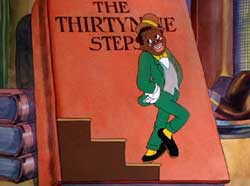 In the Technicolor Merrie Melodie Have You Got Any Castles? (1938), characters are brought alive from sundry classic books, as caricatures of Hollywood actors. In the Technicolor Merrie Melodie Have You Got Any Castles? (1938), characters are brought alive from sundry classic books, as caricatures of Hollywood actors.
One of the books in question is Green Pastures, which provides a big musical number, "I've Got Swing for Sale," performed by caricatures of Cab Calloway, Fats Waller, & the Mills Brothers. We also see Bill Bojangles Robinson dancing down & out of The Thirty-nine Steps, & Clark Gable from The House of Seven Gables.
Many other books are spoofed, but they are all books that had been adapted as movies. These cartoons were shown in cinema houses after all, & were very much for film fans rather than librarians.
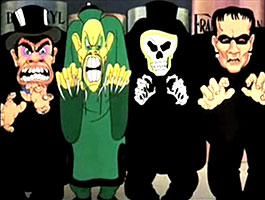 One of the finest book & film sequences begins with a close-up of books entitled Dr. Jekyl & Mr. Hyde, Fu Manchu, The Phantom of the Opera & Frankenstein. Momentarily, the spines rise up like curtains, & out step the titular characters to glower balefully into the audience, before breaking into a dainty dance. One of the finest book & film sequences begins with a close-up of books entitled Dr. Jekyl & Mr. Hyde, Fu Manchu, The Phantom of the Opera & Frankenstein. Momentarily, the spines rise up like curtains, & out step the titular characters to glower balefully into the audience, before breaking into a dainty dance.
It could well be great party-fun even today for a film club, as many of the films & actors referred to are not as well known now as in 1938 & it'd be a good trick for modern viewers to name every one of them.
In retrospect it seems sad that such charming fun-poking films could've been banned in the 1960s & have never really bounced back, being unlikely to show on television even today.
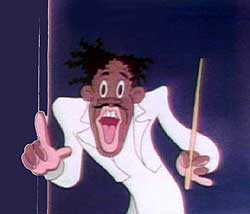 Cab vanishes entirely from the cartoon as shown on TBS, so too does a little joke on Uncle Tom played by Rip Van Winkle. Cab vanishes entirely from the cartoon as shown on TBS, so too does a little joke on Uncle Tom played by Rip Van Winkle.
When the Cuckoo Strikes (1947) condenses Have You Got Any Castles, removing two minutes, but none of it is to remove racial content. Scenes that were censored from some later copies of the original Any Castles are all to be found in Cuckoo Strikes, with the missing portions having to do with the introductory & closing Town Crier scenes which caricature bandleader & radio personality Paul Whiteman. So if you happen to have only a censored version of Anay Castles, you can see the missing bits in Cuckoo Strikes.
Certainly African Americans were recurringly stereotyped in the worst ways like watermelon-obsessed Jasper in George Pal puppetoons, & a whole slug even worse. But these spoofs in films like Have You Got Any Castles? of great jazz singers, especially of Cab, tended to be lovingly done & did not merit censorship.
Children exposed to caricatures of Cab in cartoons won't grow up racists; they'll grow up already finding familiarity in the the actual gentlemen when their music is eventually encountered for real.
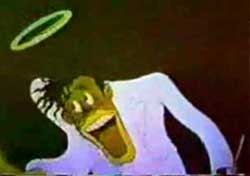 Another technicolor Merrie Melody & one of the "Banned Eleven" removed from circulation in 1968 by United Artists was Clean Pastures (1937). Another technicolor Merrie Melody & one of the "Banned Eleven" removed from circulation in 1968 by United Artists was Clean Pastures (1937).
United Artists had obtained a vast cartoon library & was responding to the sensitivity of African Americans when they shelved those which might offend African Americans.
In some cases the black caricatures were no more or less demeaning than the caricatures of whites, but the endless singlemindedness of how African Americans are caricatured justified concern. Still, by now, it's time to respect whatever achievement such films possess, & to assess more fairly those which offend, & those which poke far less hateful fun at beloved figures.
This one might indeed still offend. Clean Pastures is a spoof of the all-black-cast film Green Pastures (1936), as well as Al Jolsen's blackface performance in The Jazz Singer (1927).
In this retelling, angels visit Harlem intent on saving souls for Heaven, which is an entirely negro-run affair called Pair-o-Dice. The Stepin Fetchit angel attempts to attract souls, but other angels are more interesting to the earthlings, including angel-caricatures of Fats Waller, Cab Calloway, Louis Armstrong, etc., & earthly caricatures of Al Jolsen doing "I Love to Singa" & Bill Bojangles Robinson dancing down the street past a poster for the Savoy Club.
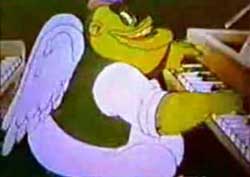 Black critics of the 1930s helped raise a controversy about the movie Green Pastures but voiced no complaint about the animated parody. Rather, Clean Pastures initially came up against the Production Code, which faulted the cartoon for satirizing religion. Black critics of the 1930s helped raise a controversy about the movie Green Pastures but voiced no complaint about the animated parody. Rather, Clean Pastures initially came up against the Production Code, which faulted the cartoon for satirizing religion.
White censors were appalled by the idea that heaven might be run by negroes. One of the critics' specific demands was that the halo be removed from such figures as Cab Calloway, since Cab was no angel!
Some of the footage was reworked & recycled a year later in Have You Got Any Castles? to get around the censors & delete the religious satire. But copies I've seen of both Clean Pastures & Any Castles? both retain Cab's halo, though reportedly some copies were touched up at one time.
Clean Pastures was again assaulted by censors when in 1968, to appease Civil Rights activists, classic cartoons with insensitive portraits of African Americans being removed from circulation. To this very day many of these have only unofficial circulation, without regard for the fact that some of these banned cartoons are authentic works of art.
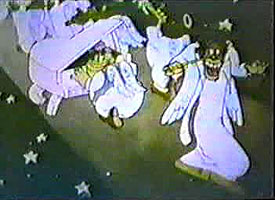 Longstanding rumor had it that Cab Calloway voiced his own material in this film, but that's ridiculous. The majority of the uncredited vocals are by Los Angeles-based African American jazz quartet The Four Blackbirds, & by Steve Gibson & the Basin Street Boys. Longstanding rumor had it that Cab Calloway voiced his own material in this film, but that's ridiculous. The majority of the uncredited vocals are by Los Angeles-based African American jazz quartet The Four Blackbirds, & by Steve Gibson & the Basin Street Boys.
The Four Blackbirds quartet consisted of first tenor Geraldine Harris, second tenor David Patillo, baritone Leroy Hurte, & bass Richard Davis. They recorded for Columbia subsidiary labels Vocalion & Melotone, & were also a component of The Original Sing Band which vocally imitated musical instruments.
The Four Blackbirds can also be seen in the musicals The Music Goes Round (1936) & Memories & Melodies (1935). As part of the Original Sing Band; aka, the Jones Boys Sing Band they appeared in musical shorts Hollywood Handicap (1938) & Streamlined Swing (1938).
The Basin Street Boys of the 1930s (there was another harmony group by that name in the 1940s) were a close harmony quartet, sometimes quintet, headed up by guitarist Steve Gibson, well known as part of the Red Caps. With him were Louis Dandridge, Joe Walls, Lloyd Mitchell, & Pods Hollinsworth.
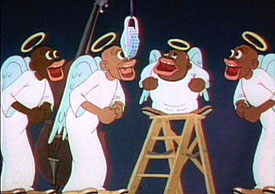 Unlike their namesake of the following decade, the original Basin Street boys never had a recording contract, but these guys contributed their vocal talents to the unfortunately titled cartoon Swing Monkey Swing (1937) with content to match the title. Unlike their namesake of the following decade, the original Basin Street boys never had a recording contract, but these guys contributed their vocal talents to the unfortunately titled cartoon Swing Monkey Swing (1937) with content to match the title.
Swing Monkey Swing is a Technicolor Columbia Pictures cartoon that takes place on an island populated by jazz-loving monkeys who are caricatures of black performers; the bandleader is another Cab Calloway caricature.
The Basin Street Boys have a lovely spot in the black-cast feature film The Duke Is Tops; aka, The Bronze Venus (1938) singing the finger-snappin' "Evening Swing." The same film also featured The Cats & the Fiddle who was a very similar harmony group, singing "Killin' Jive."
Numbers for Clean Pastures include an acapella performances of "Save Me, Sister, from Temptation," the big "spiritual" sequence done by Cab Calloway & Al Jolsen in The Singing Kid (1936), performed in the cartoon behind the opening credits; & again acapella for "Half of Me Wants to Be Good" heard in Saint Peter's office (at white censors' insistance De Lawd got renamed St. Peter to avoid the original assertion that God is a black man, though anyone who read the book or saw the movie might well puzzle over the needless change).
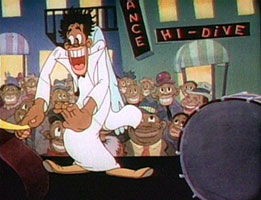 Harlem jazz is represented by bits of "Nagasaki" & "Sweet Georgia Brown," while in heaven Cab Calloway out front of his Pair-o-Dice orchestra sings "I've Got Swing For Sale," the centerpiece number of the film: Harlem jazz is represented by bits of "Nagasaki" & "Sweet Georgia Brown," while in heaven Cab Calloway out front of his Pair-o-Dice orchestra sings "I've Got Swing For Sale," the centerpiece number of the film:
"If the rhythms been too dreamy/ And you like your trumpets screamy/ That's when you should call to see me/ Cuz I've got swing for sale."
Joining in the number will be the Mills Brothers vocally impersonated but not caricatured (the four harmonizers bare not even slight resemblance to the originals). Fats Waller joins in & plays a second piano behind himself using his wings. Louis Armstrong gets a verse & a horn solo. But it's scattin' Cab who holds the number together as a whole.
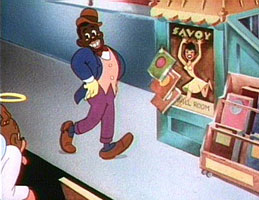 Harlem souls are attracted in droves. They receive their halos as they enter Pair-o-Dice to a syncopated revision of an old minstrel show classic "O Dem Golden Slippers" written in 1879 by black composer Jimmy Bland, who also wrote "Carry Me Back to Old Virginny." Heaven's such a lovely place now that even Satan (the film's only white guy!) repents & wants in. Harlem souls are attracted in droves. They receive their halos as they enter Pair-o-Dice to a syncopated revision of an old minstrel show classic "O Dem Golden Slippers" written in 1879 by black composer Jimmy Bland, who also wrote "Carry Me Back to Old Virginny." Heaven's such a lovely place now that even Satan (the film's only white guy!) repents & wants in.
This is a great cartoon. It is also insensitive to black culture, true enough, though alleging its creators were racists goes a bit far.
The thing about art is the content is frequently in the eye of the beholder. This could be interpretted as a tale of moral black jazzmen in a struggle against injurious aspects of jazz culture.
While black-cast films like Green Pastures & Blood of Jesus just flat out made rural life & gospel music "good," & urban life & jazz "evil," Clean Pastures posits instead that jazz culture constitutes a heavenly reflection of Earth.
The Harlem Renaissance was what heaven's all about. It can be tainted by gambling & addiction, but moral jazzmen reveal the light. It is jazz rather than some cockeyed notion of gospel singing back on the plantation which leads to redemption.
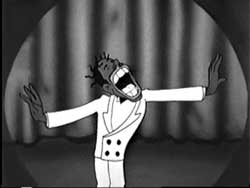 Cab is spoofed in the Walter Lantz black & white production of Hollywood Bowl (1938) Cab is spoofed in the Walter Lantz black & white production of Hollywood Bowl (1938)
Also caricatured are such illuminaries as Bing Crosby, Greta Garbo, Groucho Marx, W. C. Fields, Fats Waller, Rudy Vallee, Martha Raye. This cartoon celebrates Universal stars since Universal distributed this cartoon to cinema houses.
The selected actors & musicians all had some physical charicteristic easy to turn into a cartoon, & each very familiar to anyone who would have seen this cartoon in 1938.
And again, it might have been all too easy to rely on racial stereotyping to convey famous black people, but Cab's caricature from the Walter Lantz studio is a very pleasing one that wouldn't insult anyone.
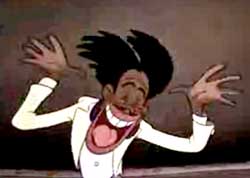 Mother Goose Goes Hollywood (1938) is a "silly symphony" musical cartoon from Disney, built around charicatures of the best known Hollywood film stars of the day.
Mother Goose Goes Hollywood (1938) is a "silly symphony" musical cartoon from Disney, built around charicatures of the best known Hollywood film stars of the day.
As pages of a Mother Goose book are turned one by one, we encounter Ed Wynn as Old King Cole & his fiddlers three the Marx Brothers. Charles Laughton in his Mutiny on the Bounty role joins Spencer Tracy & Freddy Barthelemew in their roles from Captain's Courageous, recast as the rub-a-dub team in "Three Men in a Tub."
W. C. Fields is Humpty Dumpty insulted by Charlie McCarthy in the little chickadee's nest. Katherine Hepburn in an on-going gag as Little Bo Peep ("I've lost my sheep, rally I have"). Stan Laurel & Oliver Hardy are Simple Simon & the Pie Man, provided with a couple quite good gags. Greta Garbo & Edward G. Robinson share a teeter-totter for "See Saw Marjorie Daw."
There are many others, including Cab Calloway & His Cotton Club Orchestra with special guest Fats Waller, as the four & twenty blackbirds baked in a pie. Their caricatures most resemble those from Clean Pastures & Have You Got Any Castles?
All the caricatured figures we've seen plus several others get together at the Old Lady Who Lived in the Shoe's shoe for a big final number with a good bit for Waller, fast & slow dances contrasted between Fred Astair & Stepin Fetchit; Cab doing a "Zazu" scat routine; & the big-mouth couple Martha Raye & Joey Brown jitterbugging us out of the show.
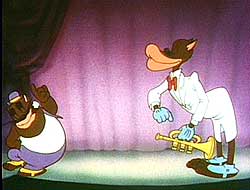 One of the "Banned Eleven," with racial caricatures of African Americans & Japanese that can offend, Tin Pan Alley Cats (1943) is a perfect example of how harmful censorship can be, since for whatever faults it may possess, this one's also quite the work of art, in site of undermining itself with stereotypes.
One of the "Banned Eleven," with racial caricatures of African Americans & Japanese that can offend, Tin Pan Alley Cats (1943) is a perfect example of how harmful censorship can be, since for whatever faults it may possess, this one's also quite the work of art, in site of undermining itself with stereotypes.
A cat which caricatures Fats Waller is the primary star. He's disinterested in Uncle Tomcat's
christian mission, but prefers the jazz venue next door, the Kit Kat Club. Cats Waller is a bit of a scalliwag with the jitterbug cat-gals. Apart from having bigger lips, I think his caricature comes close to that of Lou Costello as a mouse in A Tale of Two Mice (1945) & as a cat in A Tale of Two Kitties (1942).
When Cats Waller gets so stoned on the music that he actually hallucinates a journey to Jazz Wackyland, it turns into a nightmare which so frightens him that he afterward finds religion & joins Uncle Tomcat's cult.
In Wackyland, the song "Schlesinger Swing" is performed by a caricature of Cab Calloway, not nearly as tastefully attractive as seen in Walter Lantz's Hollywood Bowl.
Other songs heard are a jazzy "Nagasaki" & a choral "By the Light of the Silvery Moon." A small slice of the animation depicting the landscape of Wackyland was recycled from Porky in Wackyland (1938) after being colorized, but the caricatures constituted new material.
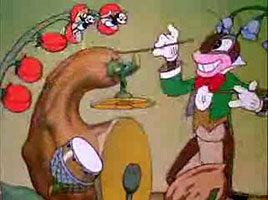 A Technicolor "Silly Symphony" from Walt Disney, Woodland Cafe (1937) is set in a bug city, full of delightful sight-gags about insects going to a wonderful jazz club. Race is evident even though everyone's an insect of one kind or another. As in the Cotton Club, the clientelle are white, the performers & wait staff are black.
A Technicolor "Silly Symphony" from Walt Disney, Woodland Cafe (1937) is set in a bug city, full of delightful sight-gags about insects going to a wonderful jazz club. Race is evident even though everyone's an insect of one kind or another. As in the Cotton Club, the clientelle are white, the performers & wait staff are black.
Very soon we get a Stepin Fetchit joke, wittier than most such jokes, but still... After having seen the cafe neon signage outside made up of fireflies, we see in the interior of the cafe lit by an array of firefly lights. One is not working, & when the caterpillar floor manager claps his hands at it, this firefly who peeps out is a Stepin Fetchit type of "lazy darkie," so of course he's not working. Fortunately we won't get too much of this sort of "joke" in what is generally a delightful cartoon.
The cricket band does not rely on too much stereotyping. They're negro cricket musicians, very appealing fellows. Every single scene on the dance floor, at the cafe tables, or of the individual band members, is gorgeously designed, the hot jazz music thrills nonstop.
There's a tremendously cool act performed by an aggressive spider in porkpie hat & a sexy little fly, who perform the violently romantic tango or French "Apache dance" on a spider web.
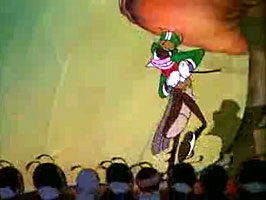 All the bugs do the jitterbug to the cricket orchestra. The dancers include a slow snail couple, a crabby old bee-man who hooks up with a red hot babe of a red ant & dances himself into a heart attack, a very talented inchworm couple, & many others shown in rapid succession, absolute fun. All the bugs do the jitterbug to the cricket orchestra. The dancers include a slow snail couple, a crabby old bee-man who hooks up with a red hot babe of a red ant & dances himself into a heart attack, a very talented inchworm couple, & many others shown in rapid succession, absolute fun.
The bandleader begins singing a superb hit of the era, "Truckin'," the lyrics for which explain how to do the dance so-named, a variation of the Lindy hop. This dance was introduced to the world at the actual Cotton Club in 1933, when Cab was a regular, but the full history of the dance could well go back to the earliest days of Kentucky minstrel shows a full century earlier, & was being done by vaudevillian & Apollo Theater star Pigmeat Markhem at the Apollo Theater in the 1920s as a specific move he named truckin'.
To the world at large Truckin' was the newest thing making its way around the world from 1933 to 1935, & still popular into the early '40s. The main moves are for solo dancer or couples was to walk with head back, feet pigeon-toed, & finger held up in front wagging back & fourth; it provided a resting point for the most acrobatic Lindy hoppers of the day.
In the hippy era this walk came to be identified with Robert Crumb's "keep on truckin man" introduced in Zap Comics in 1968, & soon featured on posters & t-shirts. But Crumb took his inspiration from Blind Boy Fuller's "Truckin' My Blues Away" which dated to 1937, as Crumb was always a hard-core fan of music of that era & valued his vintage records more highly than his comics.
Although this singing bandleader-cricket sounds nothing like Cab Calloway (he does sound good however) & is not carcatured too obviously as Cab, his lanky leggy dance is indeed Cab-like. Cab might've worn the green tux with tails, but I can't imagine he'd never have worn that green tophat as it would've hidden his lovely hair.
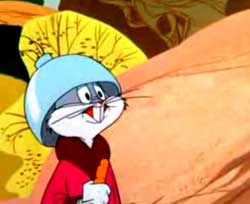 There are many other cartoons that feature Cab in one way or another, which goes to show the high degree of popularity throughout mainstream America's film-going public of the 1930s & '40s.
There are many other cartoons that feature Cab in one way or another, which goes to show the high degree of popularity throughout mainstream America's film-going public of the 1930s & '40s.
A black & white Porky Pig an anti-smoking cartoon for the kiddies, Wholly Smoke (1938) is infused with imagination.
Porky tokes a stogey obviously made with wacky tobakky. He hallucinates the character of Nick O'Teen who drags Porky off into a nightmare world where cigars, cigarettes & smoking utensiles come to life & perform songs.
Cigars resembling the Three Stooges assault him. Singing smokes include the Mills Brothers, Bing Crosby & Rudy Vallee. When Nick O'Teen gets soot on his face, he becomes a blackface performer imitating Cab Calloway -- alas not one of the pleasing caricatures. When Porky comes down from his high, he vows never again to smoke, & returns to his religion.
The elaborate adventures of two flies in Fly Frolic (1932) has as its highlight the appearance of a caricature of Cab Calloway as a Dr. Jekyll & Mr. Hide sort of guy who turns into a villainous spider. The spider sings the opium song "Kicking the Gong Around." Made by the generally third-rate Van Buren studios, it's one of their most effective & original cartoons.
In the Technicolor Little Lulu cartoon The Baby Sitter (1947), Little Lulu gets a head injury while baby sitting a nasty baby. While unconscious she dreams herself at the Stork Club where she encounters caricatures of Cab Calloway, Bob Hope & W. C. Fields.
Knight-Mare Hare (1955), spoofing Mark Twain's A Connecticut Yankee in King Arthur's Court places Bugs Bunny in the Connecticut Yankee's role. He asks the first knight he meets if he knows the Earl of Hines, the Cab of Calloway, the Duke of Ellington, the Count of Basie, the Satchmo of Armstrong, though no such caricatures ever show up in this one.
Additional Cab Calloway caricatures will be encountered in Jazz Frogs cartoons, the Krazy Kat episode Kannibal Kapers (1935), & doubtless a few others.
copyright © by Paghat the Ratgirl
|




 One of the finest book & film sequences begins with a close-up of books entitled Dr. Jekyl & Mr. Hyde, Fu Manchu, The Phantom of the Opera & Frankenstein. Momentarily, the spines rise up like curtains, & out step the titular characters to glower balefully into the audience, before breaking into a dainty dance.
One of the finest book & film sequences begins with a close-up of books entitled Dr. Jekyl & Mr. Hyde, Fu Manchu, The Phantom of the Opera & Frankenstein. Momentarily, the spines rise up like curtains, & out step the titular characters to glower balefully into the audience, before breaking into a dainty dance. Cab vanishes entirely from the cartoon as shown on TBS, so too does a little joke on Uncle Tom played by Rip Van Winkle.
Cab vanishes entirely from the cartoon as shown on TBS, so too does a little joke on Uncle Tom played by Rip Van Winkle.
 Black critics of the 1930s helped raise a controversy about the movie Green Pastures but voiced no complaint about the animated parody. Rather, Clean Pastures initially came up against the Production Code, which faulted the cartoon for satirizing religion.
Black critics of the 1930s helped raise a controversy about the movie Green Pastures but voiced no complaint about the animated parody. Rather, Clean Pastures initially came up against the Production Code, which faulted the cartoon for satirizing religion. Longstanding rumor had it that Cab Calloway voiced his own material in this film, but that's ridiculous. The majority of the uncredited vocals are by Los Angeles-based African American jazz quartet The Four Blackbirds, & by Steve Gibson & the Basin Street Boys.
Longstanding rumor had it that Cab Calloway voiced his own material in this film, but that's ridiculous. The majority of the uncredited vocals are by Los Angeles-based African American jazz quartet The Four Blackbirds, & by Steve Gibson & the Basin Street Boys. Unlike their namesake of the following decade, the original Basin Street boys never had a recording contract, but these guys contributed their vocal talents to the unfortunately titled cartoon Swing Monkey Swing (1937) with content to match the title.
Unlike their namesake of the following decade, the original Basin Street boys never had a recording contract, but these guys contributed their vocal talents to the unfortunately titled cartoon Swing Monkey Swing (1937) with content to match the title. Harlem jazz is represented by bits of "Nagasaki" & "Sweet Georgia Brown," while in heaven Cab Calloway out front of his Pair-o-Dice orchestra sings "I've Got Swing For Sale," the centerpiece number of the film:
Harlem jazz is represented by bits of "Nagasaki" & "Sweet Georgia Brown," while in heaven Cab Calloway out front of his Pair-o-Dice orchestra sings "I've Got Swing For Sale," the centerpiece number of the film: Harlem souls are attracted in droves. They receive their halos as they enter Pair-o-Dice to a syncopated revision of an old minstrel show classic "O Dem Golden Slippers" written in 1879 by black composer Jimmy Bland, who also wrote "Carry Me Back to Old Virginny." Heaven's such a lovely place now that even Satan (the film's only white guy!) repents & wants in.
Harlem souls are attracted in droves. They receive their halos as they enter Pair-o-Dice to a syncopated revision of an old minstrel show classic "O Dem Golden Slippers" written in 1879 by black composer Jimmy Bland, who also wrote "Carry Me Back to Old Virginny." Heaven's such a lovely place now that even Satan (the film's only white guy!) repents & wants in.



 All the bugs do the jitterbug to the cricket orchestra. The dancers include a slow snail couple, a crabby old bee-man who hooks up with a red hot babe of a red ant & dances himself into a heart attack, a very talented inchworm couple, & many others shown in rapid succession, absolute fun.
All the bugs do the jitterbug to the cricket orchestra. The dancers include a slow snail couple, a crabby old bee-man who hooks up with a red hot babe of a red ant & dances himself into a heart attack, a very talented inchworm couple, & many others shown in rapid succession, absolute fun.